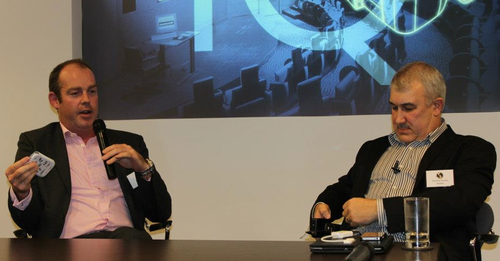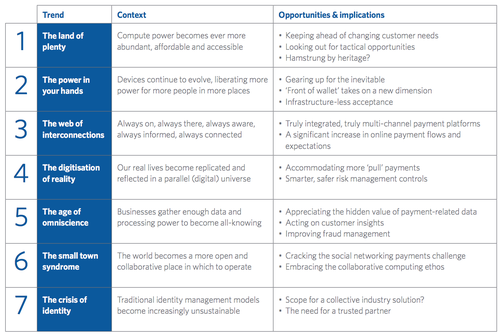5 Tech Trends Driving The Future Of Banking
Post on: 22 Сентябрь, 2015 No Comment

What will become of the branch bank?
You might soon have to bid a teary farewell to your neighborhood bank branch. As more people bank online and via smartphone, banks are evaluating the future of the old-fashioned branch.
The number of transactions in branches is plummeting, says Brett King, author of Bank 3.0 and Branch Today, Gone Tomorrow. Customers don’t visit branches as often, because people do so much more of their day-to-day banking without them.
From 2006 to 2010, the number of most types of common transactions performed inside bank branches declined, from opening bank accounts to making deposits and resolving problems, a study by industry research group Novantas LLC says.
It’s caused the industry to rethink the size, number and locations of bank branches and to look for more efficient, cheaper ways to conduct business. Neighborhood branches likely won’t completely disappear, but they’ll be smaller and have smaller staffs, says Maria Coyne, executive vice president of consumer and small-business banking for Cleveland-based KeyBank. Self-service and technology are quickly becoming the name of the game.
There’s still a place for the branch, but what happens inside is changing, she says.
Here are some of the trends driving the future of banking.
Do-it-yourself banking
The branch of the future will look more like an airport check-in than a traditional bank branch, Coyne says. Fewer tellers will manage a handful of self-serve computer screens, much like airline ticket agents at major airports do.
A handful of banks, including JPMorgan Chase & Co. PNC Bank, Bank of America and KeyBank, are testing self-service kiosks, self-service drive-thru lanes and 24-hour video-teller machines — ATMs with a two-way video feed to a live person.
Ryan McInerney, Chase CEO of consumer banking, told investors that bank customers can perform 90 percent of traditional banking transactions at self-service kiosks, and Chase plans to test the technology at up to 1,000 bank branches.
Banks are already deploying ATMs that let customers deposit cash and checks, then print a picture of it on the receipt, says Richard Hunt, president of the Consumer Bankers Association.
Self-serve centers give customers convenient, sometimes 24-hour options for conducting banking business. For pinched banks, it’s a potential pot of gold. Automation lowers the bank’s cost per transaction, making banks overall more profitable, Hunt says.
Talk to experts by teleconference
Need to meet with a mortgage loan officer or personal banker? Pull up to a computer. You’ll soon be meeting him or her via teleconference in the branch rather than in person. As the technology becomes more mainstream, eventually you’ll be able to teleconference with bankers from home, King says.
Banks, including KeyBank and Citizen Financial Group, are testing video teleconferencing in several markets.
The benefit is you can meet with all kinds of experts in far-flung locations, while in the past you’d have to wait until they came through your area, KeyBank’s Coyne says. (It’s more) flexible schedule-wise and ensures customers can meet with an expert who speaks their native language.
Customers generally will fill out forms via computer in advance, then head to their local branch for the meeting. The conference screens are very high-definition, and you really feel like the person is in the room, Coyne says. There’s no speech delay. It feels like an in-person experience.
Goodbye paper and snail mail
Banks are pushing paperless transactions in a bid to reduce costs. Wells Fargo customers can have receipts sent to personal email addresses. In a bid to reduce the nearly 1 billion paper slips its customers generate each year, Chase is testing paperless teller touch screens that can initiate routine banking transactions, such as deposits to bank accounts and check cashing, without the need to fill out a paper slip.
It saves customers the trouble of filling out a form and saves the bank money, King says.
Even the making of new bank debit cards is going high-tech. To reduce paper and mailing costs, some banks are testing instant card issuing, where a special machine inside the branch can make new or replacement cards instantly so customers don’t have to wait for them to be sent by mail. It eliminates the sometimes two-week wait for a new debit card. Chase has made about 85,000 of these cards in 58 test locations since 2008.
Still, eliminating paper and snail mail completely is a long way off, as banks will have to make a huge front-end (technology) investment in the next five years to completely get rid of it, King says.

More new, mobile types of accounts
Customers will soon be gaining more mobile-banking payment and account options. We’re going to see a lot more and different products, and a richer (banking) experience, says King.
For instance, plastic debit cards might soon be replaced by a contactless sticker — a thin adhesive that can be placed anywhere and used for purchases in place of a card — or smartphone payment app that not only lets you pay but generates reports on your spending habits, King says.
Banks already are rolling out banking software for iPads and tablets and thinking of new ways to structure bank accounts that are more purpose-built, with more options for tracking money and ways to make payments, King says.
Hunt says there will be more options, not fewer, and banks will still offer bread-and-butter checking and saving accounts, just with more modern twists. All the banking products available in 1900 are still here today — like checking and savings. As technology evolves, banks aren’t taking instruments away. They’re just adding more options, he says.
The strategy is all about meeting clients where they are, Coyne says.
Future of the branch
All of the self-service kiosks, video-teller machines, mobile and Internet banking, and industry focus on cost control eventually will translate into fewer and smaller bank branches. We’re predicting a 50 percent reduction in the number of U.S. branches by end of decade, King says.
Hunt says newly built locations and those remaining likely will be smaller. We’re estimating they’ll be about 3,000 square feet, but some will be as small as a kiosk or a hotel room, down from the current average of 10,000 square feet, he says.
There won’t be a one-size-fits-all branch anymore, Hunt says.
King says the branches will be less focused on simple transactions and more focused on sales, such as opening new bank accounts and steering customers to more profitable services and products such as retirement planning, brokerage accounts and loans.
Bank branches won’t disappear entirely. As silly as it sounds, people still like to be able to walk into a branch and see the people who are watching over their money, Coyne says.














